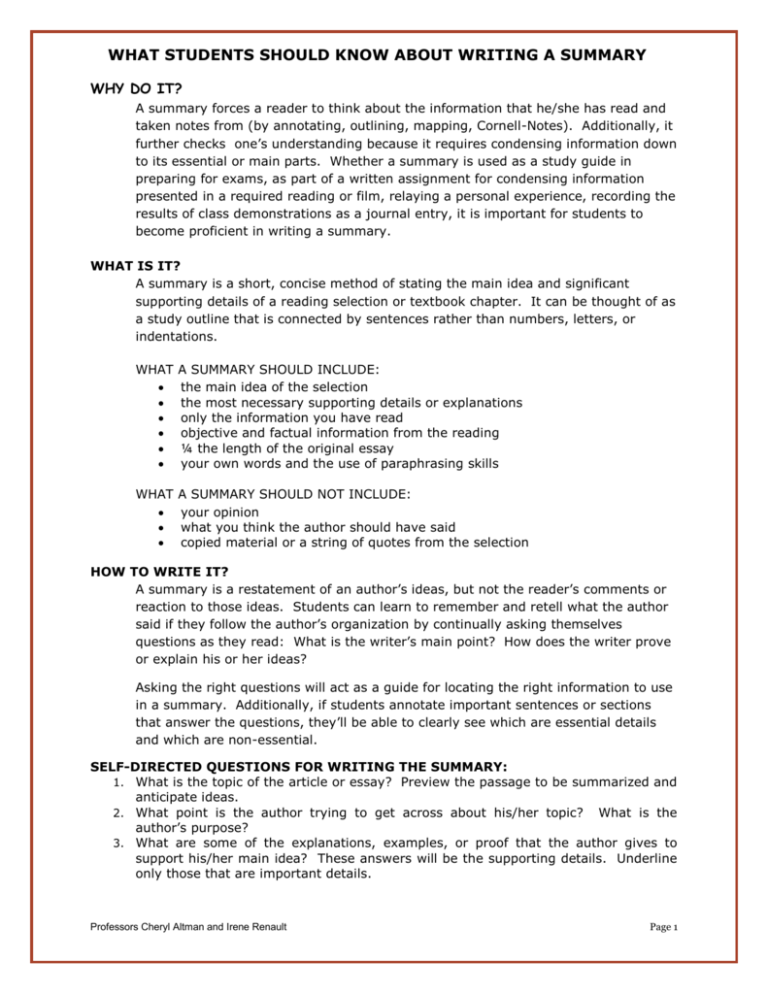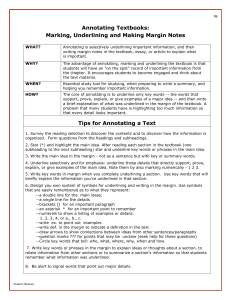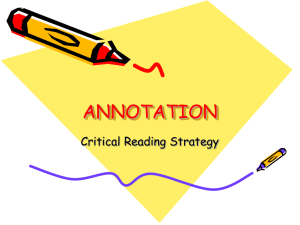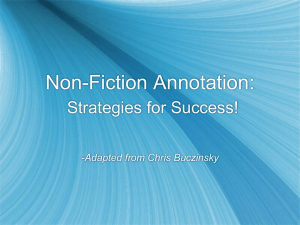Summary and Note Taking
advertisement

WHAT STUDENTS SHOULD KNOW ABOUT WRITING A SUMMARY WHY DO IT? A summary forces a reader to think about the information that he/she has read and taken notes from (by annotating, outlining, mapping, Cornell-Notes). Additionally, it further checks one’s understanding because it requires condensing information down to its essential or main parts. Whether a summary is used as a study guide in preparing for exams, as part of a written assignment for condensing information presented in a required reading or film, relaying a personal experience, recording the results of class demonstrations as a journal entry, it is important for students to become proficient in writing a summary. WHAT IS IT? A summary is a short, concise method of stating the main idea and significant supporting details of a reading selection or textbook chapter. It can be thought of as a study outline that is connected by sentences rather than numbers, letters, or indentations. WHAT A SUMMARY SHOULD INCLUDE: the main idea of the selection the most necessary supporting details or explanations only the information you have read objective and factual information from the reading ¼ the length of the original essay your own words and the use of paraphrasing skills WHAT A SUMMARY SHOULD NOT INCLUDE: your opinion what you think the author should have said copied material or a string of quotes from the selection HOW TO WRITE IT? A summary is a restatement of an author’s ideas, but not the reader’s comments or reaction to those ideas. Students can learn to remember and retell what the author said if they follow the author’s organization by continually asking themselves questions as they read: What is the writer’s main point? How does the writer prove or explain his or her ideas? Asking the right questions will act as a guide for locating the right information to use in a summary. Additionally, if students annotate important sentences or sections that answer the questions, they’ll be able to clearly see which are essential details and which are non-essential. SELF-DIRECTED QUESTIONS FOR WRITING THE SUMMARY: 1. What is the topic of the article or essay? Preview the passage to be summarized and anticipate ideas. 2. What point is the author trying to get across about his/her topic? What is the author’s purpose? 3. What are some of the explanations, examples, or proof that the author gives to support his/her main idea? These answers will be the supporting details. Underline only those that are important details. Professors Cheryl Altman and Irene Renault Page 1 Now, when written in sentences, the answers to the above questions will become the summary in paragraph form. Steps for Writing a Summary: STEP 1. Title: Put the title of the essay on the first line, centered. Skip a line between the title and the first sentence of your summary. STEP 2. First Sentence: In the first sentence you must including the following information: a. the title of the selection b. the author(s), if this is available or the source (where the article came from) c. the Thesis Statement - main idea(s) of the selection. What is the author trying to tell you about the topic? What is his/her central message? SAMPLE OPENING SENTENCE: A. The article/essay/novel "_______________________," (title) by ___________________ [the author(s)] (claims/discusses/states/explains/questions) ____________________________________. [thesis statement / main idea paraphrased] OR B. According to ______________________ in his/her (their) article “_______________," discusses that ___________________________________________________. [thesis statement / main idea – paraphrased] STEP 3. Author's Explanation and Development. Follow the thesis/main idea statement with details that directly support, explain or prove the author's main point idea. Include important explanations or examples of these major supporting details. Students should try to use their own words for the summary. If a student uses more than three consecutive words from the article, use quotation marks. Students may quote an important phrase or sentence, but the summary should never be a string of quotations. STEP 4. The Concluding Sentence Start the last sentence with transition words, such as: in conclusion, in summation, or in summary. Restate the thesis statement (the main idea of the article). STEP 5. Final Check Proofread the summary and check for spelling, punctuation, grammar and coherence. Students should make sure they have used their own words – paraphrase and don’t copy! STEP 6. Review: Read the original essay again. Has the summary followed the same organization of thought as the article? Students should make certain that they haven't added their opinion or reaction. The summary should be an objective writing. Professors Cheryl Altman and Irene Renault Page 2 METHODS OF ORGANIZING INFORMATION Textbook Organizing Method Annotating How to? Note Taking – Cornell Method Why? System of notations – identify [mi], important details, key words in margin Using marks to help organize the material visually – number & underline the details, Read entire passage first, then annotate fast information is all in one place textbook becomes a workbook 2 inch margin on left – key words, 6” side - details on right Jot down brief sentence summaries of important information Margin space on left to identify topics working with pen and paper improves attention to material forces concentration Outlining Get an overview before you start Use Roman numerals, indentations, letters, and numbers to show levels of importance organizes information from books and lectures highlights main topics Mapping Visual system of condensing material to show relationships Place topic/mi in center, determine main ideas & significant details Use lines to show relationships between mi, major details, minor details Keeps you an active reader and thinker improves memory by grouping ideas/facts in a visual way quick reference or overview of an article or chapter Professors Cheryl Altman and Irene Renault Page 3 HOW TO TAKE TEXTBOOK NOTES USING CORNELL NOTES (2-6 METHOD) 1. The key to this notetaking system is to draw a vertical line about 2 ½” from the left edge of the paper. 2. In the right hand column, record the important supporting points or details of the lecture. 3. In the left-hand column, record only key words or phrases that summarize the important supporting points from the right-hand column. 4. Strive to capture the general ideas of the section rather than nonessential details. Focus on the content or main words Don’t write everything down – only major points of emphasis in the reading Use abbreviations, numbers or letters to indicate sequence, stages, facts, etc. FORMAT FOR NOTETAKING: Key words/ideas/ main points 2 ½” Professors Cheryl Altman and Irene Renault Details/supporting points/answers 6” Page 4 MAPPING: A GRAPHIC ORGANIZER It’s an alternative to note taking and outlining and an excellent way to gain experience in identifying major details and minor supporting details is to outline or map a selection. This forces you to selectively search for the important points. By reorganizing the information you have read, you can clearly see the relationships between the details and the author’s main idea. Seeing these relations is a critical skill for effective studying, reading, and writing. WHAT? A map is a graphic summary of reading material. Important information (major ideas, supporting details and conclusions) is organized to illustrate significance and relationships. WHY? "Knowledge has an internal connectedness, a meaningfulness, and for facts to be appreciated, understood and remembered, they must be fitted into that (a mapped) context." Harvard Center for Cognitive Studies WHEN? Mapping is an essential study tool. It can be used when organizing expository writing, preparing essay exam questions, and studying vocabulary as well as when organizing reading. HOW? Determine the map’s starting point by identifying the main idea and placing it in a prominent position on single sheet of paper. Identify the major and minor supporting details and connect them to the main idea in a design that reveals relationships. Use drawings, colors and shapes that reflect a student’s personality and learning style. Main Idea Major detail #1 Supporting Detail Major Detail #2 Major Detail #3 Supporting Detail Professors Cheryl Altman and Irene Renault Page 5 ANNOTATING TEXTBOOK: MARKING, UNDERLINING AND MAKING MARGIN NOTES WHAT? Annotating is selectively underlining important information, and then writing margin notes on the textbook, essay, or article to explain what is important. WHY? The advantage of annotating, marking and underlining the textbook is that students will have an "on the spot" record of important information from the chapter. It encourages students to become engaged and think about the text material. WHEN? Essential study tool for studying, when preparing to write a summary, and helping you remember important information. HOW? The core of annotating is to underline only key words -- the words that support, prove, explain, or give examples of a major idea -- and then write a brief explanation of what was underlined in the margin of the textbook. A problem that many students have is highlighting too much information so that every detail looks important. TIPS FOR ANNOTATING A TEXT 1. Survey the reading selection to discover the contents and to discover how the information is organized. Form questions from the headings and subheadings. 2. Star (*) and highlight the main idea. After reading each section in the textbook (one subheading to the next subheading) star and underline key words or phrases in the main idea. 3. Write the main idea in the margin - not as a sentence but with key or summary words. 4. Underline selectively and for emphasis: underline those details that directly support, prove, explain, or give examples of the main idea. Note them by also marking them numerically - 1 2 3. 5. Write key words in margin when you complete underlining a section. Use key words that will briefly explain the information you've underlined in that section. 6. Design you own system of symbols for underlining and writing in the margin. Use symbols that are easily remembered as to what they represent: --a double line for the main ideas; --a single line for the details --brackets [] for an important paragraph --an asterisk * for an important point to remember --numerals to show a listing of examples or details. 1, 2, 3, 4, or a., b., c. --write ex. to point out examples --write def. in the margin to indicate a definition in the text --draw arrows to show connections between ideas from other sentences or paragraphs --question marks ??? for points that may be unclear (seek help for these questions) --Circle key words that tell: who, what, where, why, when and how. 7. Write key words or phrases in the margin to explain ideas or thoughts about a section, to relate information from other sections or to summarize a section's information so that students remember what information was underlined. 8. Be alert to signal words that point out major details. Professors Cheryl Altman and Irene Renault Page 6








